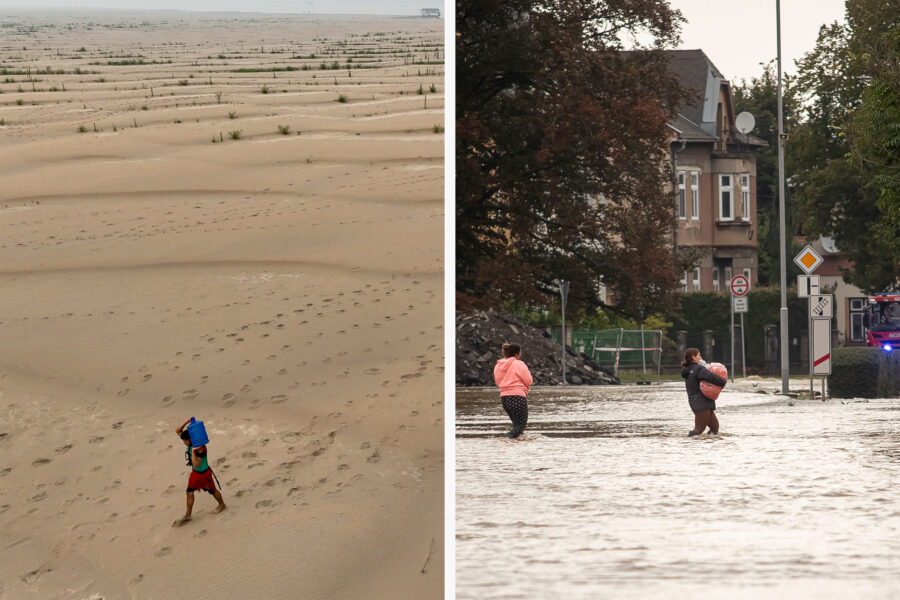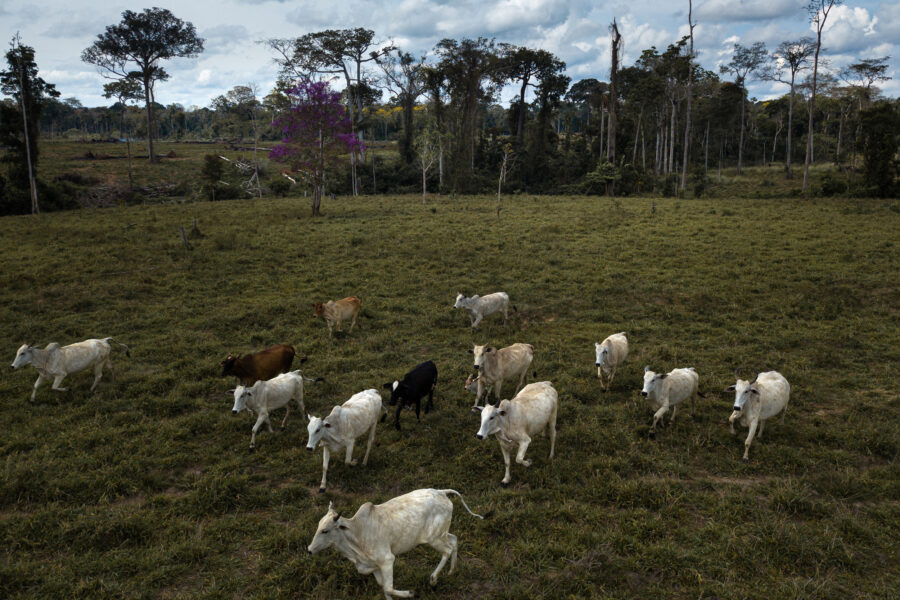Fine Particulate Matter Air Pollutants, Known as PM2.5, Have Led to Disproportionately High Deaths Among Black Americans
Nestled beside traffic-choked New York Avenue NE, the historically Black Ivy City neighborhood in Washington, D.C., was built in the late 19th century as a community for African American laborers who soon found themselves living amid industrial sites and a racetrack.
Today, the neighborhood, like so many in D.C., is partially gentrified but can’t completely escape the environmental inequities of its past or the suffocating exhaust from traffic of present rush hours.
“A lot of us are experiencing issues with breathing,” said Sebrena Rhodes, an Advisory Neighborhood Commission member and organizer with the nonprofit Empower DC. “Everybody is experiencing the exact same thing.”
Ivy City is an archetypal “environmental justice” community in which residents have for years been disproportionately harmed by pollution, as a growing body of research makes clear.
Explore the latest news about what’s at stake for the climate during this election season.
A study published last month in the journal Nature Medicine by Assistant Professor Pascal Geldsetzer and other researchers and collaborators at the Stanford University School of Medicine found that Black Americans have had the highest proportion of deaths from fine particulate matter air pollution, known as PM2.5, when compared to all other racial or demographic subgroups from 1990 to 2016.
Fine particulate matter includes particles produced primarily through vehicle fuel emissions and other burning of oil, coal and wood that are less than 2.5 micrometers in diameter, small enough to lodge deeply in the lungs, affect other vital organs and even enter the bloodstream.
PM2.5, about one-thirtieth the diameter of a human hair, causes a range of harmful health effects, from aggravating asthma and other respiratory illnesses to increasing the risk of death from lung cancer, heart disease, dementia and stroke.
“It’s very well recognized that PM2.5 is the biggest environmental killer globally,” said Tarik Benmarhnia, associate professor at the University of California San Diego’s Scripps Institution of Oceanography and the study’s senior author.
Researchers found that Black Americans had the highest PM2.5-attributable mortality in 96.6 percent of U.S. counties and faced a “double jeopardy,” being more exposed to PM2.5 pollution and more susceptible to its adverse health effects due to poverty, existing medical conditions, more hazardous jobs and lack of access to housing and health care.
“Exposures to air pollutants, broadly, are not shared equally. They fall disproportionately on racial minorities throughout the U.S.,” said Marshall Burke, an associate professor at Stanford’s Doerr School of Sustainability and a co-author of the study.
The study examined other social factors such as education, income, and rurality. Yet researchers found the starkest disparities in analyzing the data by race and ethnicity. “Our results indicate the strong association of race/ethnicity with adverse environmental health outcomes; an association that is even stronger than for education, rurality or social vulnerability-related factors,” the study says. “This finding aligns with a growing body of evidence demonstrating that racial/ethnic categories are not simply proxies for socioeconomic differences but are also proxy measures, while imperfect, for exposure to historical and contemporary discriminatory practices.”
The study noted enormous progress from 1990 through 2016 in reducing PM2.5 pollution. In 1990, 85.9 percent of the U.S. population was exposed to average PM2.5 levels above 12 micrograms per cubic meter, the threshold set by the Environmental Protection Agency. By 2016, the percent of the population exposed to average levels above the threshold had fallen to just .9 percent of the population. In February, the EPA lowered the threshold to 9 micrograms.
In 1990, the PM2.5-attributable mortality rate for Black Americans was 350 deaths per 100,000 people, compared to less than 100 for the other racial groups researchers considered: American Indian or Alaska Native, Asian or Pacific Islander, Hispanic or Latino white, non-Hispanic white and White. By 2016, mortality had fallen for all races, with Blacks experiencing the largest decline, to 50 deaths per 100,000. Yet Black mortality remained highest among all racial groups.
“The Clean Air Act has cleaned up the air for everyone, but it has actually cleaned it up disproportionately,” said Burke. “The racial gap has declined, but the inequalities remain so that the gap has not gone down to zero.”
Only “point source” pollution, emissions from a fixed structure or area, are regulated under the Clean Air Act. Hence, vehicle emissions—like those coming from New York Avenue NE—or wildfire smoke from Canada are not regulated. However, if a certain location continually exceeds safety limits, then it may be regulated. Regulating air emissions in such cases compared to other environmental contamination sites is much more difficult because of the diffuseness of the pollution source.
“We are killing a lot more people by way of our emissions than we actually are by violence and air pollution is the top source of that.”
With effective legislation and targeted action, the air can become cleaner, as has been the case with the Clean Air Act, said Burke. He added that the energy transition to renewables and, ultimately, net zero emissions will also lower the concentration of air pollutants. During the transition, it is essential to target specific areas to reduce inequalities and clean the air across the United States, he said.
“In addition to being systematically more exposed to higher levels of air pollution, structurally disadvantaged communities are also thought to be more susceptible to adverse health effects from air pollution,” according to the study. “Sources of air pollution emissions are often located in marginalized communities, as residents of these areas tend to have less economic opportunity, resources and social capital, as well as limited political power to influence the decision-making processes that determine where such sources of pollution are placed.”
“High income neighborhoods are often able to fight these things in a way that low income neighborhoods are not,” said Burke.
But the resulting health consequences are devastating—for everyone. “Global life expectancy loses three years on average just due to toxic air pollution. And that’s just death. That doesn’t include sickness,” said Richard “Drew” Marcantonio, an air pollution expert at the University of Notre Dame’s Kroc Institute for International Peace Studies. “We are killing a lot more people by way of our emissions than we actually are by violence and air pollution is the top source of that.”
Even if someone is receiving care for a pollution-related health concern, it is often misdiagnosed, especially in disadvantaged communities, said Rhodes, the 57-year-old Ivy City activist. “When you are suffering from a certain type of disease or ailment, they’re not looking at it as being environmental,” she said. “They’re looking at other factors like genetics or your habits.”
The Environmental Justice Amendment Act of 2023, introduced by D.C. Council member Zachary Parker, who represents Ivy City, requires that the “cumulative impact” of pollution be considered before more polluting industries are permitted for a neighborhood like Ivy City. But the ongoing impact of current and previous polluting entities burning fossil fuels, in addition to the traffic on New York Avenue NE, remains a threat, as the Stanford study makes clear.
About This Story
Perhaps you noticed: This story, like all the news we publish, is free to read. That’s because Inside Climate News is a 501c3 nonprofit organization. We do not charge a subscription fee, lock our news behind a paywall, or clutter our website with ads. We make our news on climate and the environment freely available to you and anyone who wants it.
That’s not all. We also share our news for free with scores of other media organizations around the country. Many of them can’t afford to do environmental journalism of their own. We’ve built bureaus from coast to coast to report local stories, collaborate with local newsrooms and co-publish articles so that this vital work is shared as widely as possible.
Two of us launched ICN in 2007. Six years later we earned a Pulitzer Prize for National Reporting, and now we run the oldest and largest dedicated climate newsroom in the nation. We tell the story in all its complexity. We hold polluters accountable. We expose environmental injustice. We debunk misinformation. We scrutinize solutions and inspire action.
Donations from readers like you fund every aspect of what we do. If you don’t already, will you support our ongoing work, our reporting on the biggest crisis facing our planet, and help us reach even more readers in more places?
Please take a moment to make a tax-deductible donation. Every one of them makes a difference.
Thank you,
David Sassoon
Founder and Publisher
Vernon Loeb
Executive Editor
Share this article
Disclaimer: The copyright of this article belongs to the original author. Reposting this article is solely for the purpose of information dissemination and does not constitute any investment advice. If there is any infringement, please contact us immediately. We will make corrections or deletions as necessary. Thank you.








